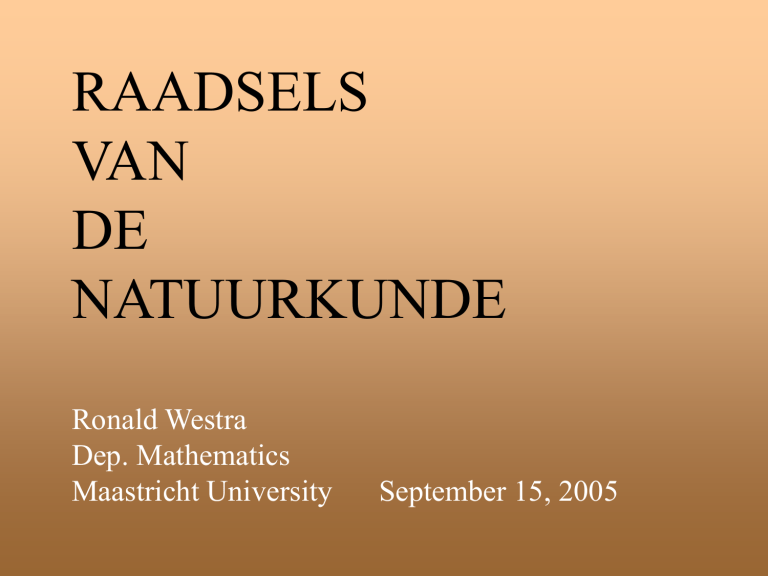
RAADSELS
VAN
DE
NATUURKUNDE
Ronald Westra
Dep. Mathematics
Maastricht University
September 15, 2005
Deel 1
Van NEWTON
tot EINSTEIN
CPART I: Basis definities
IInhoud
Een stukje geschiedenis
De wetenschappelijke methode
De taal van de natuur
De aard van de natuurkundige wetten
M Behouden grootheden
Historie van de Natuurkunde
De geschiedenis van de
moderne natuurkunde
Thomas Kuhn (1922-1996 )
The Structure of Scientific
Revolutions (~1962 )
Thomas Kuhn (1922-1996 )
The Structure of Scientific
Revolutions (SSR) (1962)
Central idea :
Science does not evolve
gradually toward truth, but
instead undergoes
periodic revolutions which
he calls "paradigm shifts."
De rol van
Observaties
en
Experimenten
St. Augustinus
Alle waarheid volgt
direct uit de Heilige
Schrift.
(De Civitate Dei, 5th
eeuw a.D.)
René Descartes
1596-1650
Meditationes de Prima
Philosophia (1641):
Er bestaan
onveranderlijke
natuurwetten in ruimte en
tijd waaraan alle
bouwstenen van de natuur
aan gehoorzamen.
René Descartes
1596-1650
Deze natuurwetten
zijn volkomen
logisch en zijn door
logisch redeneren
met gebruik van
wiskunde volledig te
achterhalen.
Het is dan ook niet nodig om deze wetten
experimenteel te controleren
René Descartes
1596-1650
Descartes proceeds to
construct a system of
knowledge, discarding
perception as unreliable
and instead admitting
only deduction
as a method.
Blaise Pascal
1623 - 1662
De eerste formulering
van de
wetenschappelijke
methode:
Blaise Pascal
“Om aan te tonen dat een
hypothese evident is,
is het niet voldoende dat
alle phenomenen hieruit
volgen; integendeel, het
leiden tot het tegendeel
van een enkel phenomeen
volstaat om de valsheid
hiervan te bepalen”
Uit briefwisseling met Estienne Noel (1648)
Blaise Pascal
Dit bracht hem in conflict
met vele prominente
wetenschappers,
waaronder Descartes.
De
Wetenschappelijke
Methode
De Wetenschappelijke Methode
Experiment / Observatie
(Mathematische) Theorie
Isaac Newton (1642-1727)
Voorbeeld: zwaartekracht
Observaties aan
bv planeetbanen
Experimenten
met bv valbewegingen
en slingers
(Mathematische) Theorie
Newton zet de standaard
T * Absolute ruimte en tijd
* afgeleide grootheden: snelheid,
versnelling, impuls
· * abstractie van een puntmassa
* abstracte grootheden: kracht, energie
* abstracte grootheden:
kracht hangt van positie af
*
Newton zet de standaard
T * De natuurwet als principe:
[1] de ratio van de verandering van de
impuls van een puntmassa is gelijk aan de
resulterende kracht die op de puntmassa
werkt
[2] de zwaartekracht op een bepaalde
plek h de ratio van de verandering van
de impuls is gelijk aan de kracht van een
massa van M kilo op een puntmassa op
is omgekeerd evenredig met het kwadraat
van de afstand r van zijn centrum
VVolgens Newton
T tijd t
plaats x
impuls p
kracht F
dx
pm
dt
dp
F ( x, t )
dt
Mm
F ( x, t ) G 2
r
VVolgens Newton
T
N Na Newton
T * mathematisering van de natuurkunde
· * Verdere uitbreiding van abstracte
grootheden: Krachtvelden, Lagrangiaan
* BV: Electro-Magentisme : Maxwell
N James Clerk
Maxwell
(1831-1879)
T ElectroMagentisme
NMichael Faraday
(1791-1867)
T Experimentele
vindingen en
principes:
de wet van Faraday
N James Clerk
Maxwell
Wetten van het
Electro-Magnetisme
HHendrik Lorentz
Max Planck
(
Alle problemen zijn opgelost,
alleen drie kleine probleempjes
(
1. Ultraviolet catastrophe,
photo-electric effect
2. Michelson-Morley and aether-theory
3. Brownian Motion
Ultraviolet catastrophe
TThe ultraviolet catastrophe, also called the
Rayleigh-Jeans catastrophe, was a prediction of
early 20th century classical physics that an
ideal black body at thermal equilibrium will emit
radiation with infinite power. As observation
showed this to be clearly false, it was one of the
first clear indications of problems with classical
physics.
Michelson-Morley
experiment
Velocity of light does not depend on own
velocity
Michelson-Morley experiment
Brownian Motion
Molecules wiggle in fluid
Albert Einstein
Special Relativity (1905) RT
Photoelectrisch effect (1905) QM
Brownian Motion (1905) Chaos Theory
Special Relativity
In all inertial frames the velocity of light
has the same value.
Direct mathematical consequences:
• time-intervals and lengths differ for
different observers
• Energy and mass are related as: E = mc
2
Relativistic Four-Vectors
x
space: x + time: ict form: ξ
ict
I
Lorentz-transformation: A T
i
v
with :
c
, and:
i
1
1
1
2
space and time mix into
one 4-dimensional entity:
spacetime
spacetime transforms as:
ξ ' Aξ
time: t’
time: t
event
space: x’
space: x
References
1. Stephen Hawking – The Universe
(‘Het Universum’)
2. Brian Greene – The Elegant
Universe
3. Lee Smolin – The Life of the
Cosmos
4. Roger Penrose – The Emperor’s
New Mind
5. A. Einstein – The Principle of
Relativity (collection of original publications)
Natuerconde, van NEWTON tot
EINSTEIN












